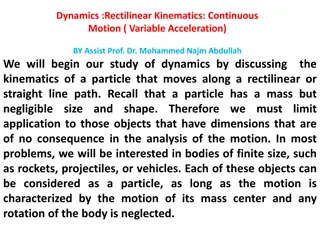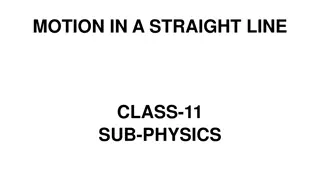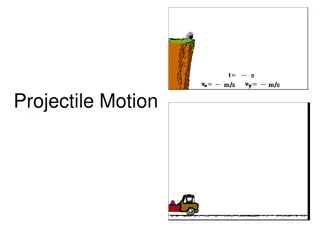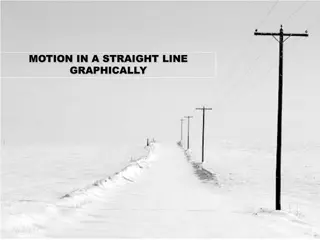Understanding Motion Along a Straight Line
Exploring kinematics in the context of motion along a straight line, this chapter delves into parameters like displacement, velocity, speed, and acceleration. Kinematics is distinguished from dynamics, focusing on how objects move without delving into why. Displacement, a key concept, is discussed as a vector quantity with both magnitude and direction. Examples illustrate how displacement is independent of actual distance traveled. The chapter sets the foundation for studying motion in one dimension.
Download Presentation

Please find below an Image/Link to download the presentation.
The content on the website is provided AS IS for your information and personal use only. It may not be sold, licensed, or shared on other websites without obtaining consent from the author. Download presentation by click this link. If you encounter any issues during the download, it is possible that the publisher has removed the file from their server.
E N D
Presentation Transcript
Unit: Motion Along A Straight Line
Unit: Motion Along A Straight Line How do you describe the motion of a particle? Why can a woodpecker survive the severe impacts with a tree limb?
Chapter 2 Motion Along a Straight Line In this chapter we will study kinematics, i.e., how objects move along a straight line. The following parameters will be defined: Displacement Average velocity Average speed Instantaneous velocity Average and instantaneous acceleration For constant acceleration we will develop the equations that give us the velocity and position at any time. In particular we will study the motion under the influence of gravity close to the surface of the Earth. Finally, we will study a graphical integration method that can be used to analyze the motion when the acceleration is not constant.
Kinematics vs. Dynamics Kinematics is the study how things move Dynamics is the study of why things move
Kinematics is the part of mechanics that describes the motion of physical objects. We say that an object moves when its position as determined by an observer changes with time. In this chapter we will study a restricted class of kinematics problems Motion will be along a straight line. We will assume that the moving objects are particles, i.e., we restrict our discussion to the motion of objects for which all the points move in the same way. The causes of the motion will not be investigated. This will be done later in the course. Consider an object moving along a straight line taken to be the x-axis. The object s position at any time t is described by its coordinate x(t) defined with respect to the origin O. The coordinate x can be positive or negative depending whether the object is located on the positive or the negative part of (2-2) the x-axis.
Displacement Displacement. If an object moves from position to position , the change in position is described by the displacement 1x 2x = For example if and then x = 12 5 = 7 m. The positive sign of x indicates that the motion is along the positive x-direction. If instead the object moves from and then x = 1 5 = -4 m. The negative sign of x indicates that the motion is along the negative x direction. Displacement is a vector quantity that has both magnitude and direction. In this restricted one-dimensional motion the direction is described by the algebraic sign of x. Note: The actual distance for a trip is irrelevant as far as the displacement is concerned. Consider as an example the motion of an object from an initial position m to x = 200 m and then back to . Even though the total distance covered is 390 m the displacement then is x = 0. 5 x m = 12 x m 1 2 = 5 x m = 1 x m 1 2 = 5 x m = 5 x m 1 2
14 What is the average velocity of a particle, whose motion is described by the below position - time graph, from t = 0 s to t = 4 s? x (m) A -2 m/s B -0.5 m/s C 0 m/s D +0.5 m/s E +2.0 m/s Answer E t (s) https://njctl.org/video/?v=ygGfndEMwqk
15 What is the average velocity of a particle, whose motion is described by the below position - time graph, from t = 2 s to t = 4 s? x (m) A +3.0 m/s B 0.33 m/s C 0 m/s D -0.33 m/s E -3.0 m/s Answer A t (s) https://njctl.org/video/?v=SUnZAgecI6Y
16 Explain, using the definition of slope, why the average velocity from t = 0 s to t = 4 s was less than the average velocity from t = 2 s to t = 4 s. x (m) The slope of the line connecting the particle's position change between 0 and 4 s was less than the slope of the line connecting the particle's position change from 2 to 4 s. Hence, the average velocity was greater for the 2 to 4 s interval. Answer t (s) https://njctl.org/video/?v=x7dcBMXySbM
Derivatives Looking at these two graphs, which one can you find the instantanious velocity at 15 seconds and which one can you not? Also, explain why you can t find the instantaneous velocity for that graph.
Instantaneous Velocity Average velocity is used to define a particle's motion over a specified interval of time, but that is not always what is most interesting. For example, a police officer is not interested in your average velocity over a two hour period. But, he is very interested in your velocity at a specific given time. This is more fundamental then it seems - the officer, even though he probably doesn't realize it, actually wants your velocity at a time interval of zero seconds! The officer is looking for your instantaneous velocity to ensure you're obeying the speed limit. https://njctl.org/video/?v=TkFXKb--Q8s
Instantaneous Velocity Let's see how the average velocity equation works for a zero second time interval. It's problematic because algebra doesn't handle fractions with a zero in the denominator. t = 0 is not good Sir Isaac Newton recognized this problem and came up with the concept of a zero time interval and invented calculus so he could solve problems like this. Calculus involves taking a time interval and shrinking it until it is infinitesimally close to zero. You'll learn more about this in your Calculus class - but you can tell the teacher you first saw it here. Calculus was invented for Physics.
Instantaneous Velocity Point P2 moved closer to the fixed point P1 as the time interval between positions was made smaller. Note that x decreased. The slope of the line connecting the two points (the average velocity) also changed. What should we continue doing? x (m) x (m) P2 P2 x x P1 P1 t t (s) t (s) t
Instantaneous Velocity Continue to decrease t, until P2 is infinitesimally close to P1 - just as t gets infinitesimally close to zero. When we get "there," the slope of the line at P1 is the instantaneous velocity. It is also tangent to the position - time curve at time t1. x (m) x2 P1 x1 t (s) t2 t1
Instantaneous Velocity The average velocity equation was used as t kept decreasing until it almost hit zero, at which point the instantaneous velocity of the particle was found. We call that a "limit," as follows: Instantaneous velocity is labeled vx, and the dx/dt term is called the "derivative of x with respect to t." The derivative of a graphed function is also the slope of the tangent line to the function at that point. The derivative of the position is the velocity. Your calculus course will cover this in more depth.
17 Explain how instantaneous velocity is derived by starting with average velocity. Use algebra, graphical analysis and a little bit of calculus in your response. Use the definition for average velocity, but then keep shrinking the time interval; this will also decrease the change in position. When the time interval is close to zero, average velocity is now the instantaneous velocity. The slope of the tangent line at the point of interest is the instantaneous velocity. Answer https://njctl.org/video/?v=R8mEo3ABlOM
Finding the Derivative (Power Rule) Example:
Example: 20 Derive the following function f (x) = 3 f(x) = 3x - 2
Example: 21 Derive the following function f(x) = -x2 +4x + 5 f (x) = -2x + 4
Example: 22 Derive the following function f(x) = -x2 + 12x - 28 f (x) =-2x +12
21 If the position of a particle as a function of time is x(t) = 2t3 + 4t2 + t + 18, what is its velocity at t = 3 s? A B C D 103 m/s E 111 m/s 61 m/s 79 m/s 97 m/s Answer B https://njctl.org/video/?v=j-gh0HCSLi8
Integration Looking at these two graphs, which one can you find the total displacement? Also, explain why you can t find the displacement for the other graph.
Finding the Integral Power Rule Example
The Definite Integral If is continuous on [a,b] then the area under the curve is the integral of from a to b. The integral represents the "net area" meaning all area above the x-axis minus any area below the x-axis. The expression is read as: "The integral fromatobof f(x) dx." or "The integral from atobof f(x) with respect to x."
The Antiderivative There are many ways to describe an antiderivative, but the most common is to say it is the "opposite of taking the derivative". In other words, if you are given the derivative of a function, the antiderivative would be the original function that the derivative came from. Antiderivative: A function, , is an antiderivative of the function if . Therefore, if and only if
5 Evaluate the following integral: A 24 C Answer B 44 antiderivative C 34 D 38 E I need help https://njctl.org/video/?v=AZb_udFWgmo
Calculating Antiderivatives This is a Quick Reference for common Antiderivatives.
Calculating Antiderivatives The "C" represents a constant term in the antiderivative. We do not know what it is because when finding a derivative initially, the constant term in the function "disappears" or rather When evaluating definite integrals, we do not need to worry about it, because it would cancel out (regardless of its value) when you subtract like this:
6 Evaluate: A 4 A B 8 Answer C 8 D 4 E I need help https://njctl.org/video/?v=dSvCPsQScNQ
Example 28 An object starts at an initial position of 0m. Its velocity as a function of time is v(t) = 3t2 + 2t + 6. What is its position at t = 4s. 104 m
Conceptual Example #4 (A) Under which scenario does the car s speed increase? Decrease? (B) In which scenario does the car have a negative acceleration? A & D Increase B & C Decrease B & D























